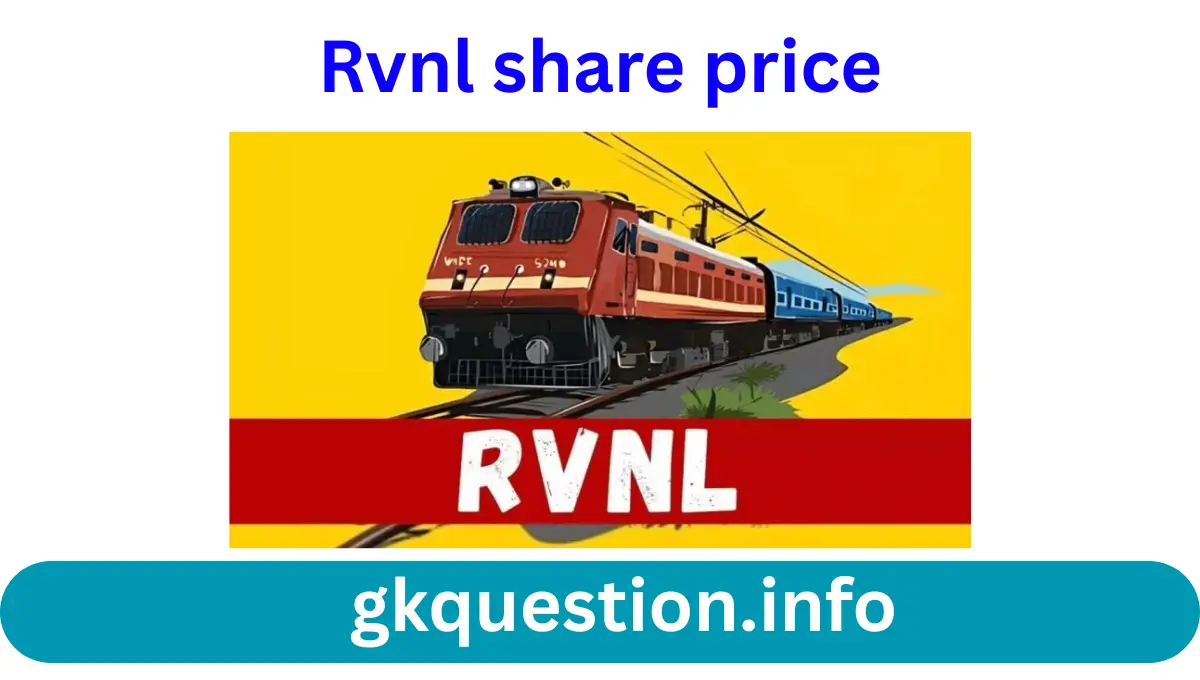RVNL Share Price – If you have been keeping an eye on the buzz in the Indian stock market, particularly among infrastructure and railway stocks, then you must have heard the name RVNL. Rail Vikas Nigam Limited has evolved from a modestly calm public sector undertaking (PSU) to a headline-making stock, fascinating retail and institutional investors alike. Its price journey has been the subject of numerous discussions, dominated by sensational rallies and severe corrections.
But what’s the actual tale behind those fluctuations in prices? Is RVNL share price a genuine indicator of India’s infrastructural boom, or is it caught up in a trend of market sentiment? This article is not about providing you with a buy or sell recommendation. It’s about dissecting the fundamentals, the drivers, and the story behind why this stock remains such an interesting case study. So, let’s go into the universe of RVNL.
What is RVNL? The Engine Behind the Infrastructure
Before we move on to studying the share price chart, it’s essential to know what RVNL does. Investing without knowing this is like getting into a train without knowing where it’s headed.
Rail Vikas Nigam Limited is a Mini Ratna Category-1 PSU of the Ministry of Railways. It was set up in 2003 and its fundamental purpose is to develop the rail infrastructure in India in a fast time frame. But unlike its relative IRFC, which is a funding company, RVNL is an executing agency. Consider RVNL to be the project manager that converts a blueprint into a reality.
Its major tasks are:
- Project Implementation: Developing new railway lines, doubling the existing ones, gauge conversion, and constructing major bridges.
- Finance Models: It tends to operate on a Turnkey model or through Special Purpose Vehicles (SPVs), split costs with state governments and other collaborators.
- Metro Projects: One of the major growth drivers for RVNL has been its expansion into metro rail projects in different Indian cities, diversifying revenue.
In a sense, when you put your money into RVNL, you are putting your money into the company actually building the backbone of India’s railway and urban transit growth.
Key Drivers Behind the RVNL Share Price Movement
The RVNL share price does not move in isolation. It is shaped by a mix of strong fundamentals, market forces, and general economic policies. Here are the key drivers at work:
1. Government’s Capex Push: The biggest single driver. The Indian government’s unshakeable concentration on infrastructure, with the railways being allocated a huge capital expenditure in each Union Budget, is a direct boost to RVNL. Each such announcement of new dedicated freight corridors, new railway lines, or metro extensions translates into a new order book potential for the company.
2. Order Book and Project Pipeline: For an EPC (Engineering, Procurement, and Construction) company such as RVNL, its order book is the blood and oxygen. A robust and expanding order book, usually bordering on lakhs of crores of rupees, offers visibility on revenues for several years ahead. Investors scrutinize the announcement of new project awards closely, as they are a direct reflection on future profits.
3. Financial Health and Margins: The bottom line and top line figures reveal the true picture. The following are the most important metrics that investors monitor:
* Revenue Growth: Top-line growth consistently demonstrates that the company is delivering its projects successfully.
* Net Profit: The bottom line reflects cost-efficient management and profitability.
- Operating Margins: This indicates how well the company manages its project costs. Consistent or rising margins are an extremely good indicator.
4. Metro Rail Expansion: The phenomenal urbanization and impetus towards metro schemes in other urban centers other than Delhi and Mumbai have created a gigantic secondary market for RVNL. Securing contracts for metro projects, both domestic and increasingly international, takes away its dependence on straight railway projects and is regarded as a key growth driver.
5. PSU Sentiment and Valuations: RVNL tends to trend with the flow of the overall PSU basket. When there is a sentiment in PSU stocks because of government stability, divestment policies, or favorable valuations, RVNL is boosted. But when there is a sector-wide correction, it can drag it down. Analysts also evaluate valuations based on measures like Price-to-Earnings (P/E) ratio to analyze whether the stock is overvalued in relation to its historical mean and peers.
6. Forays Overseas: RVNL’s forays in overseas projects (say, in Bangladesh, Nepal, or Sri Lanka) indicate its increasing capability and present new, profitable avenues. Successful bids abroad are considered highly positively by the market.
**The Recent Rally and Volatility: Why the Swings?
If you observe the chart of RVNL share price in the last couple of years, it is like a rollercoaster ride. This volatility has occurred due to a couple of important reasons:
- The Great PSU Rally: There has been a huge re-rating of PSU stocks as investors have appreciated their better governance, robust order books, and yielding dividends. RVNL was one of the major beneficiaries of this movement.
- Retail Investor Momentum: The stock was highly popular with retail investors, owing to favorable news flow and momentum-driven buying. This tends to result in phases of high-speed price gains that occasionally move ahead of near-term fundamentals and, subsequently, sharp profit-booking.
- Budget Guesstimates: The share is extremely price-sensitive to the Railway Budget (now included in the main Union Budget). Leaks, hopes, and the eventual allocation can all induce huge pre- and post-budget fluctuations.
- News-Driven Bubbles: News of winning new projects, joint ventures, or overseas contracts tends to trigger near-instant share price spikes as the market absorbs the favorable development.
The Long-Term Track: What’s Ahead?
It is impossible to predict the price of RVNL tomorrow. A more useful exercise is to determine its long-term path.
The underlying story for RVNL continues to hold. India’s infra deficit is huge, and the requirement of modern railways and city transit is not a five-year plan, but a three-decade initiative. As a prime implementation vehicle for the government, RVNL can be a direct beneficiary of this three-decade trend.
Yet, the investor should be prepared to take a bumpy ride. The stock will continue to experience fits and starts of consolidation and correction following steep advances. The trick is to pay attention to the health of the business, not the daily ticker tape.
Conclusion
The saga of the RVNL share price is a powerful page in the growth story of India. It is a concrete wager on the country’s physical progress, laid track by track.
For a potential investor, the strategy must be research-based. Consider its quarterly order book reports, track its debt levels, and watch out for government policy. RVNL can be a sound component of a diversified portfolio for people who believe in the India infrastructure tale and have the ability to hold out through market cycles.
As always, know the business, your risk tolerance, and make an informed choice. The train of infrastructure development is pulling out of the station; the question is, are you going to be on board for the long term?
Disclaimer: This post is informational and educational in nature. It is not intended as a recommendation to purchase or sell any securities. Consult with a qualified financial adviser prior to making any investment choices.




